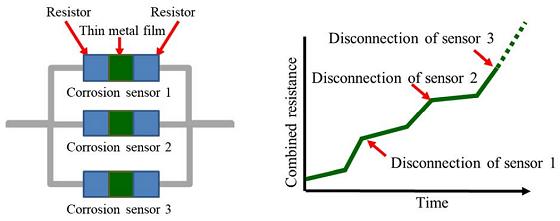Electrical and electronic equipment manufacturer Mitsubishi Electric Corp. (Tokyo, Japan) announced that it has developed what the company believes is the world’s first compact metal corrosion sensor (Figure 1) small enough to be mounted onto a printed circuit board.
The new sensor utilizes corrosion monitoring technology developed by the manufacturer to detect the degree of corrosion of metal components caused by corrosive gases, such as sulfur compounds in the atmosphere.
Usual Industrial Limitations
Historically, the company explains, quantitative analysis of color change or of rust in metal components has frequently been performed in industrial plants to determine their susceptibility to corrosion.
In emerging countries in particular, where air pollution can be a concern, the manufacturer cites growing demand for proactive countermeasures. The objective of any countermeasure is to help prevent equipment failures by better monitoring the progress of metal corrosion.
“However, it is difficult to accurately monitor the corrosive environments inside equipment housings, since conventional diagnostic technologies use external sensors to measure corrosive gases in the atmosphere,” the company explains in a news release explaining the technology.1
Benefits of Compact Size
By contrast, the compact and mounted nature of the new innovation allows for a more accurate understanding of the environment inside each piece of equipment.
Measuring just 1.6 mm by 0.8 mm, the company’s new metal corrosion sensor incorporates a thin metal film and resistors. This enables it to be mounted directly to printed circuit boards and deployable across industrial equipment. High sensitivity is achieved by serially connecting the resistors to a thin metal film, which acts as a conductor.
The ability of the sensor to more closely match the environment inside the equipment can also eliminate the need to install additional measuring instruments, the company explains, such as external sensors.
Corrosion Detection in Stages
Another benefit is that the degree of corrosion can be detected in stages (Figure 2). According to the manufacturer, the progress of any corrosion can be gauged by measuring the increase in electrical resistance of the corrosion sensors. The resistance of the sensors can be adjusted by changing the composition and thickness of the metal content.

“When metals are exposed to corrosive gases in the atmosphere, corrosion progresses from the surface to the inside and turns into rust,” the company says. “Since the electrical resistance of rust is tens of thousands of times higher than that of metal, the progress of any corrosion can be gauged by measuring the increase in electrical resistance.”
Thus, the deployment of multiple sensors with different levels of corrosion resistance should help to better prevent equipment failure, according to the manufacturer, which has two pending patents for the technology—one in Japan and one outside of Japan.
Over time, the company says it plans on deploying the new technology across its own industrial equipment portfolio.
Source: Mitsubishi Electric, www.mitsubishielectric.com.
Reference
1 “Mitsubishi Electric Develops World's First Metal Corrosion Sensor Designed for Mounting on Printed Circuit Boards,” Mitsubishi Electric News Releases, Sept. 4, 2019, https://www.mitsubishielectric.com/news/2019/0904.html (Nov. 18, 2019).